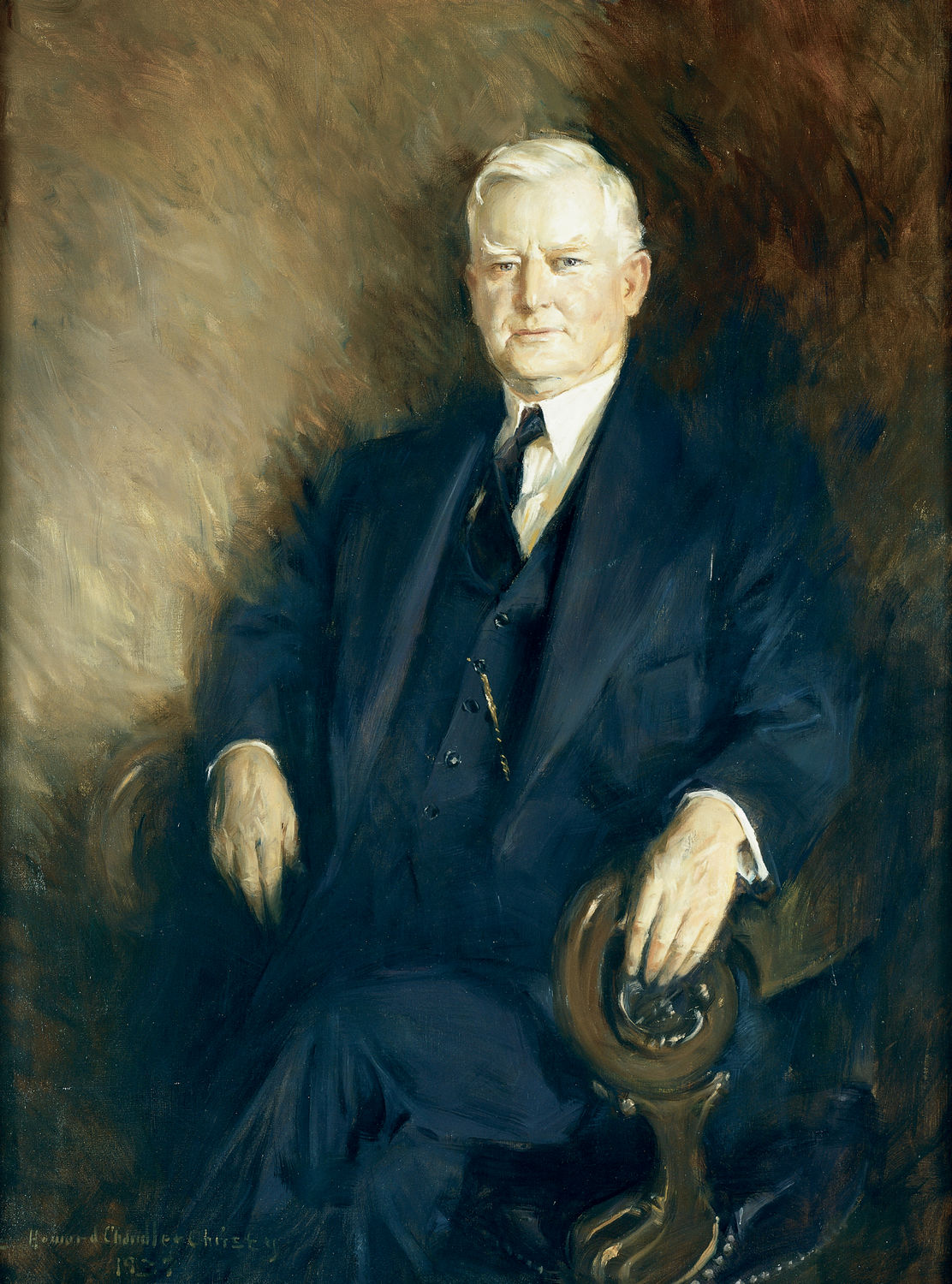
| Title | John Nance Garner |
| Artist/Maker | Howard Chandler Christy ( 1873 - 1952 ) |
| Date | 1937 |
| Medium | Oil on canvas |
| Dimensions | Sight: h. 45.625 x w. 38.75 in. (h. 115.8875 x w. 98.425 cm)
Framed: h. 54.125 x w. 40.1875 in. (h. 137.4775 x w. 102.0763 cm) |
| Credit Line | U.S. Senate Collection |
| Accession Number | 31.00007.000 |
Howard Chandler Christy, a popular illustrator and painter who was famous for his chic “Christy Girls” and piquant nudes, also had a sober and serious side. Indeed, later in life he reduced his illustration contracts in order to devote more time to painting landscapes, historical scenes (including the large mural Scene at the Signing of the Constitution of the United States in the east staircase of the U.S. Capitol’s House wing), and portraits. Christy painted John Nance Garner in 1937 during Garner’s second term as vice president. The 75th Congress approved the purchase of the portrait the following year and authorized $2,500 for the purpose.
Garner was about 64 when this painting was created. According to Christy’s representation, he was a robust figure with a massive head and a thick neck. A 1943 marble bust of the vice president by James Earle Fraser, also in the U.S. Senate Collection, offers a similar depiction. The bushy eyebrows and thick, wavy hair appear in both portraits, but Christy’s version idealizes the sitter more than Fraser’s does, making Garner less fleshy and downplaying his hooked nose. Christy’s Garner is a pleasant, frank, unpretentious personality that brings to mind Roosevelt’s appellation for his vice president: “Mr. Common Sense.” The pugnacity and political tenacity evidenced by Garner during his nearly four decades as congressman, Speaker, and vice president is more apparent in Fraser’s likeness, while it has been moderated—made mannerly—by Christy. Certainly, there is nothing in Christy’s portrait to suggest the opposition that Garner expressed for Roosevelt’s controversial “court-packing” plan. When it was introduced on the floor of the Senate in February, the vice president held his nose and “gave an emphatic ‘thumbs-down’ sign.” [1]
The artist chose an unusually large format for the seated three-quarter-length portrait, and he justifies it by both the bulk of his sitter and the freedom of his painterly technique. The latter is comparable to that of John Singer Sargent, especially in the varied, broadly painted area of light gray in the upper left background and in the loosely painted, but convincingly powerful, hands resting on the massive, ornate armchair. Despite these accomplished details, Christy’s portrait falls short of Sargent’s virtuosity, as evidenced by the inconsistent relationship between figure and ground (Garner’s right side is pushed forward by the light, but his nearer left shoulder sinks into the dark shadow) and by inconsistent technical skill (Christy’s virtuosity is displayed in the head, hands, and background but abandoned in the costume).
Also remembered for his series of army, navy, and Liberty Loan posters during World War I, Christy painted many prominent individuals, including Presidents Harding, Hoover, and Coolidge. His full-length portrait of First Lady Grace Coolidge is in the White House collection, as is his reproduction portrait of Rachel Donelson Robards Jackson, wife of President Andrew Jackson. In addition, Christy’s paintings of House Speakers William Bankhead and Henry Rainey also hang in the U.S. Capitol. Other important likenesses by this artist include those of Chief Justice Charles Hughes and Amelia Earhart.
1. Mark O. Hatfield, Vice Presidents of the United States, 1789-1993 (Washington, D.C.: Government Printing Office, 1997), 390
John Nance Garner, a U.S. representative and 32nd vice president of the United States, was born in Red River County, Texas. He served in the Texas state legislature and in 1902 was elected as a Democrat to the U.S. House of Representatives, where he distinguished himself as an expert parliamentarian. Known as "Cactus Jack," the plainspoken and unpretentious Garner displayed simple tastes and a pragmatic style. He was elected minority leader in 1929 and became Speaker two years later when his party won control of the House.
At the Democratic National Convention in 1932, Garner was a leading candidate for the presidential nomination until he was persuaded to withdraw in favor of Franklin Roosevelt. To avoid deadlock at the convention, Garner accepted the vice presidential nomination, albeit reluctantly. Although he later expressed dissatisfaction with the vice presidency, describing it as "the spare tire on the automobile of government" [1] and "not worth a bucket of warm spit," [2] Garner's political acumen proved highly valuable in his role as president of the Senate. Garner served two terms and was considered one of the most influential 20th-century vice presidents. Having broken with Roosevelt in 1937 over the president's controversial attempts to pack the Supreme Court with New Deal sympathizers, Garner did not join Roosevelt when he ran for an unprecedented third term in 1940. Instead, the vice president retired to Texas, where he enjoyed the role of political pundit until his death in 1967.
1. Jules Whitcover, Crapshoot: Rolling the Dice on the Vice Presidency: From Adams and Jefferson to Truman and Quayle (New York: Crown, 1992), 400.
2. Bascom Nolly Timmons, Garner of Texas: A Personal History (New York: Harper, 1948), 176.